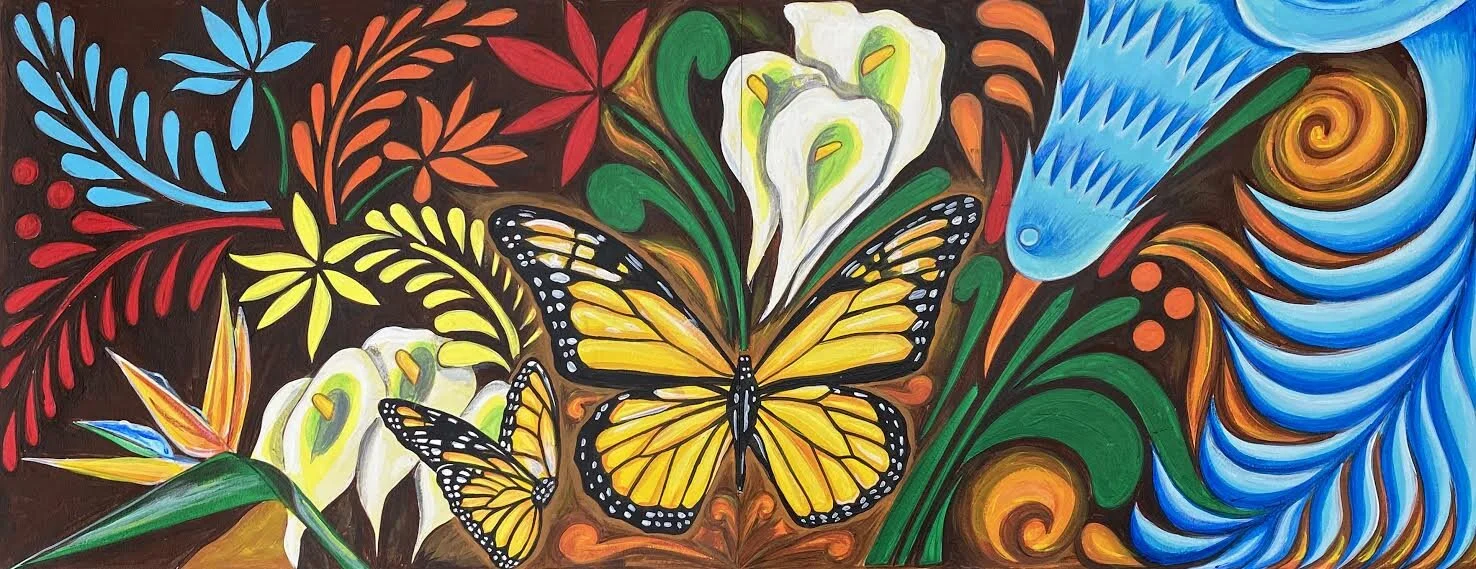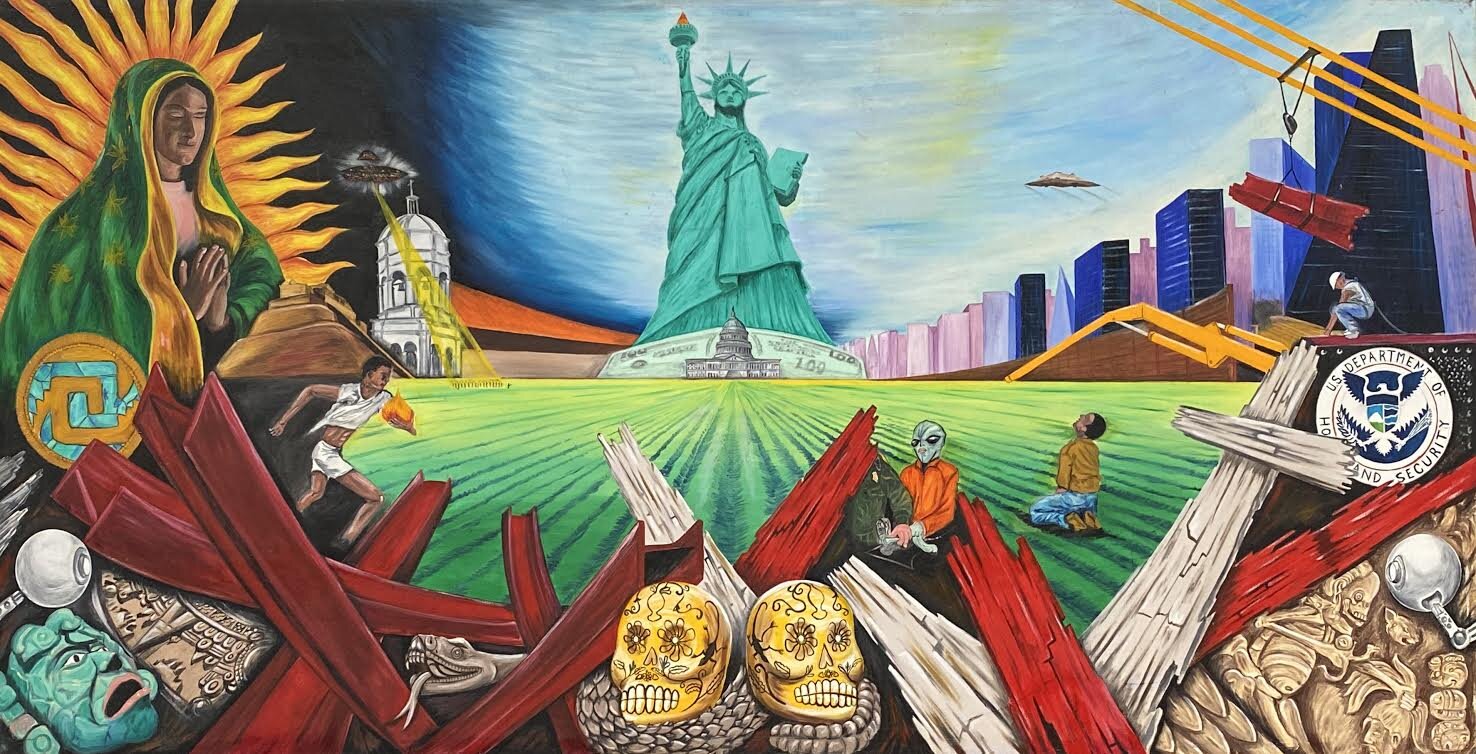Cornelio Campos
Illustration by Antonio Alanis
Cornelio Campos is a muralist, painter, and educator whose art is displayed on walls and in galleries across America. We discussed his themes and motivations.
What is the role of public art?
The role of public art is the connection between the community and the artist. For me, it’s a representation of helping the city because art helps elevate society.
Butterflies and geometric patterns feature prominently in your latest mural. Are any of the themes or tools employed in your work symbolic?
Chapel Hill Street mural, Durham 2020
Monarch butterflies, skeletons, and pre-Colombian symbols appear frequently throughout my work. To me, butterflies represent a concept of a world without borders, because the Monarch butterfly travels between the U.S. and Mexico freely, specifically in my home state of Michoacan.
Does the large size of your creations connect to the feeling you are trying to convey?
Lately, I’m focused on murals because the city is changing and creating opportunities for more public art. 20 years ago when I started my art career, I used small images on canvas. As the years went by, I began to expand to larger canvases, then eventually to murals. So much so, that I now work on more murals than smaller pieces of art. Yes, I’ve always wanted to express my own indigenous culture, and mural-making in downtown Durham gave me an opportunity not only to do that, but also to connect with some of the most well-known Mexican modernists, Frida Kahlo and Diego Rivera, using my own artwork.
What is Mexican Modernism?
Mexican Modernism is a genre of art that focuses on displaying Mexican culture through the visual expression of our own heritage, traditions and shared experiences. Some artists who have had a large influence on my work are Salvador Dali, as well as three prominent muralists: Jose Clemente Orozco, David Siqueros, and Diego Rivera.
What motivates you to create?
In the beginning, it was my immigrant experience; creating art helped me to deal with the transition between cultures. It also helped to keep me connected with my own roots, located in Michoacan, Mexico. And lately, it helps me represent my culture through exhibits and murals.
Does your art feature a story or purpose?
My art is the story of my immigration experience, and in it, I narrate the struggles that I had coming into this country, facing the new culture and language. The purpose of my art is to express my thoughts and feelings, and what I have discovered is that they are also the shared experiences of millions of other immigrants in the United States. In the beginning, my own naturalization experience was hard because I did not understand the culture or the language at all. As the years went on, it got easier and easier for me to communicate. As of now, it’s been worth it because I’ve been able to achieve parts of my own “American Dream.” So while I still consider Mexico my home (my roots and fond memories of my childhood are there), the U.S. is my home away from home. It gave me the chance to live out my dream of becoming an artist.
What brought you to Durham?
In the early 90’s, I used to work in tobacco fields in North Carolina. Eventually, one of the relatives I lived with decided to move back to Mexico, and I moved in with another relative who lived in Durham. I took up several different jobs, from construction to landscaping to electrician, all the while also practicing my art.
How does the North American Free Trade Agreement affect Mexican immigration?
I believe that it is supposed to help everyone involved, but it seems that in practice, the smaller Mexican businesses cannot compete with larger American businesses, so people emigrate in order to work at the American businesses that are better off. It sort of works against itself. The good thing about America is that there are many opportunities that another country may not be able to provide. I think a good start at facilitating a more positive change would be to have the ability for us to communicate more freely with one another, regardless of our own thoughts and beliefs. It has to come from both sides - to create a mutual understanding of each other.
What is your dream project?
Ever since I was a child, I’ve had a dream to have an exhibit of my work in my hometown of Cheran. Since moving to Durham, I’ve had the opportunity to strongly develop my art career, which in turn has given me many opportunities to display my work in various regions of North Carolina as well as at the Smithsonian Institute. It has also allowed me to create a mural here in Durham, which has been my “hometown” for many years.
What advice would you offer to muralists just getting started?
My advice is to follow your dreams, but keep in mind that it might not be easy to do so. However, the end result of having your work admired by the community is well worth the effort. Remember: success is whenever you are able to be happy with whatever you do, no matter how small or large your project.
You can click here to own a piece from Campos.





